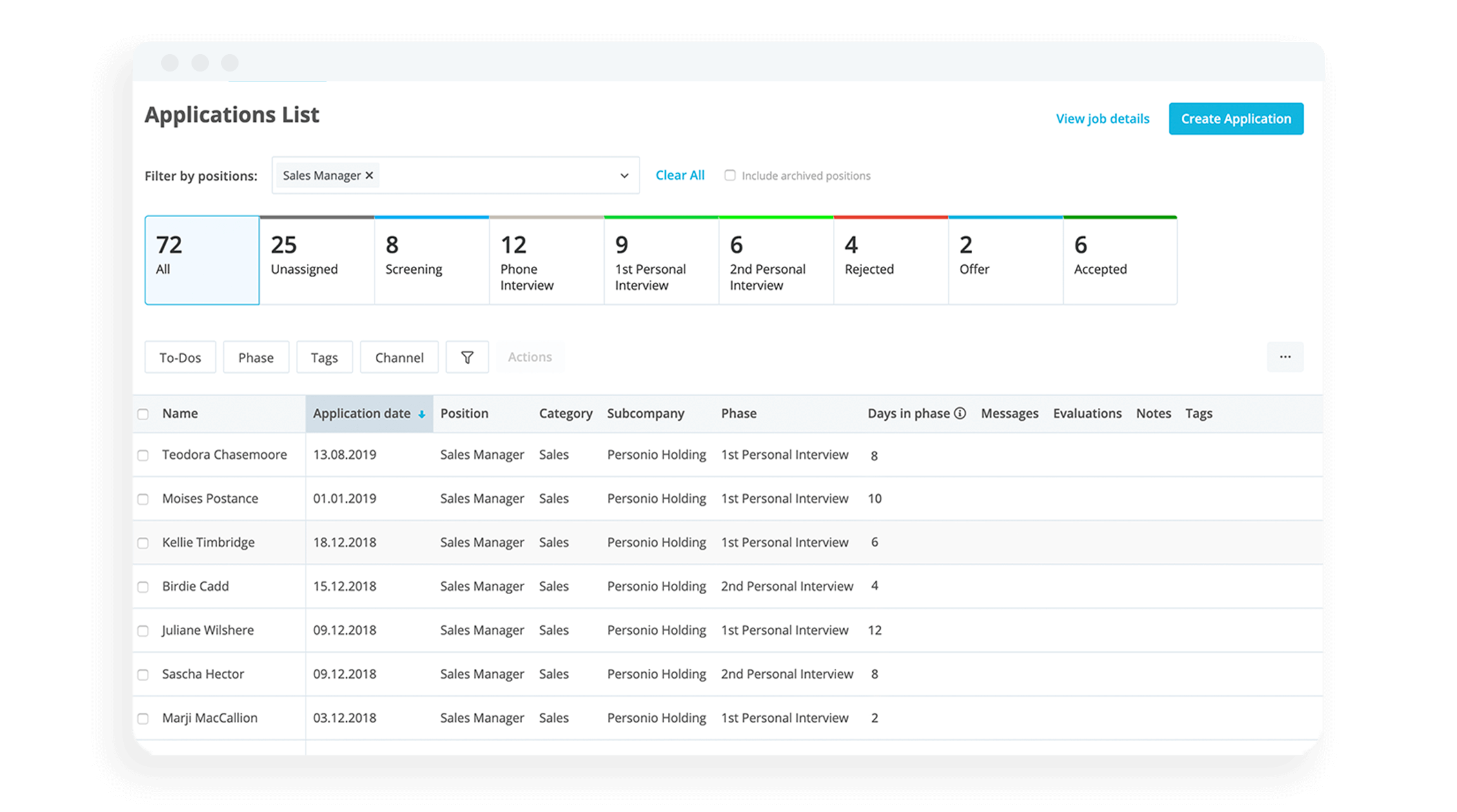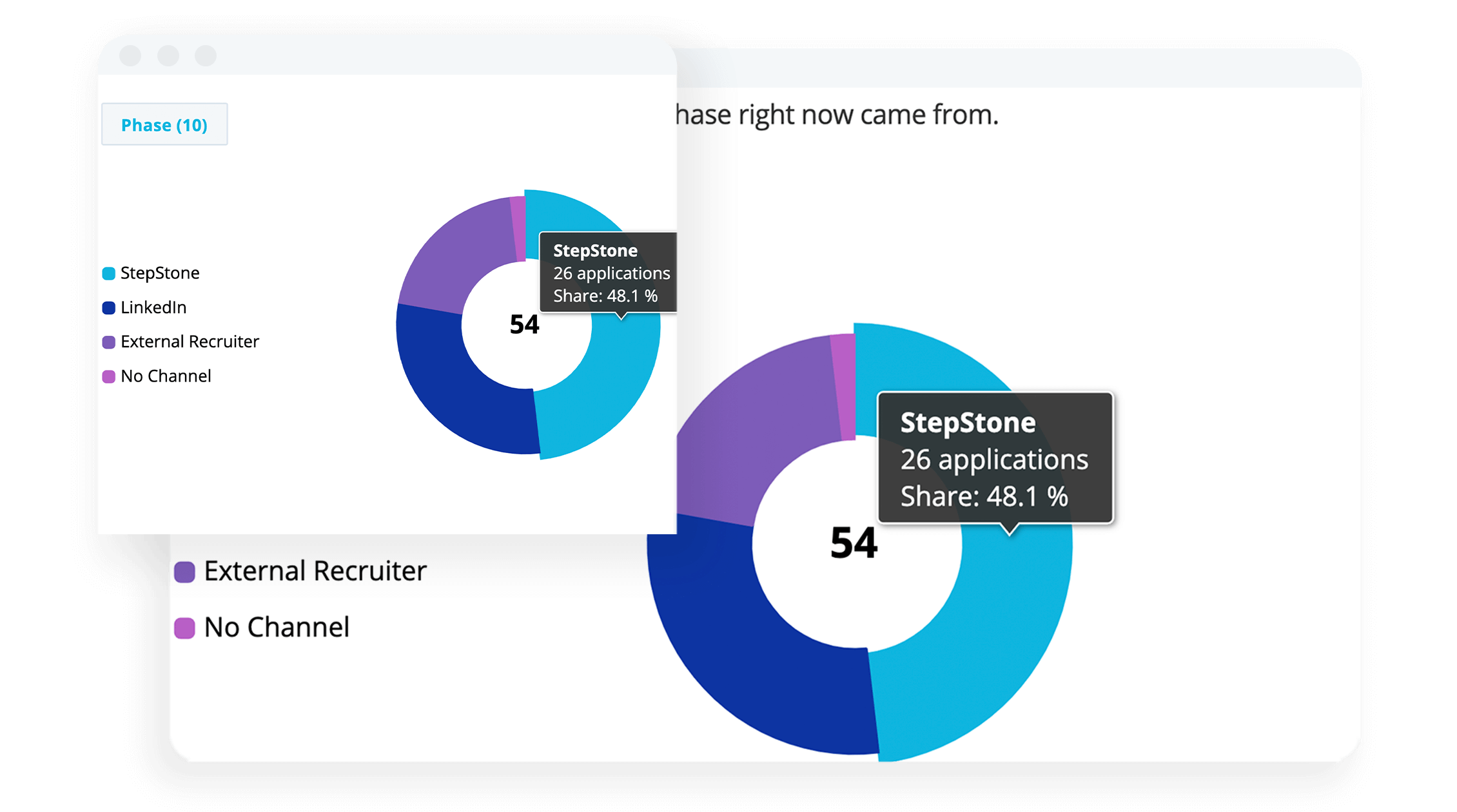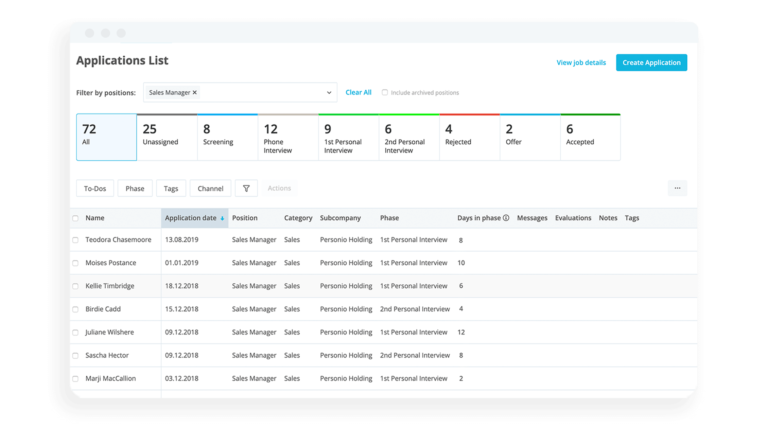What is an Applicant Tracking System? Definition & Practical Tips

An applicant tracking system is not simply defined by who you hire, but how you hire. It includes the methods, means and processes that help guide candidates through your company's applicant process. Here’s our guide on the subject.
Cut your time-to-hire in half with Personio’s Applicant Tracking System.
What is an Applicant Tracking System?
An applicant tracking system (ATS) offers an easy way for organisations to collect applicants, turn them into candidates and hire them as employees. It does this by collecting information and documents, managing communications, organising interviews, sending out offers and helping manage all the processes in between.
What Is the Goal of an Applicant Tracking System?
The success of an applicant tracking system hinges on reaching three goals:
Saving time and money
Finding the perfect candidates
Improving your employer brand
Goals are one thing, but actually executing those goals is another. Let’s talk about the three key goals and how an ATS can help unlock them…
1. Saving Time & Money
One of the most important goals of a great applicant tracking system is how quickly it can process applicants. After all, an applicant who spends weeks on hold is the same as an applicant who has gone to your next competitor – great talent simply doesn’t wait around forever.
An ATS can help with automating the tasks involved in processing applicants. Things like sending confirmation emails are not only necessary, but they add to the overall candidate experience. They help applicants know what to expect.
This not only opens up time for your HR team, but it optimises the entire recruiting process from start to finish.
2. Finding the Perfect Candidates
First things first: According to our research with Bitkom, companies that use software for applicant tracking conduct significantly fewer interviews while hiring just as many employees.
It’s because everything is organised and the stages are clearly outlined. So, companies focus less on the mechanics of hosting interviews, and more on candidate quality.
At the same time, an applicant tracking system enables you to collect data on your processes and report on them. You can figure out, in real-time, which channels are working the best and which don’t need more budget put behind them.
The key takeaway: You can cut costs, quickly, while still finding the ideal candidates. That’s the beauty of multiposting.
3. Improving Your Employer Brand
Shortened processes and automated touchpoints mean one thing: Your applicants spend less time waiting around and more time interacting with your organisation.
After all, you don’t get a second chance to make a first impression. The application process will often define how a potential employee thinks and feels about your organisation – and, whether or not they want to work for you.
So, if you treat them to a great experience, they will gain a better impression of your team, engage more during the process and be more likely to accept an offer down the road.
Best Practice: The same study from Personio found that 95% of applicants turn down offers because they already found a job in the meantime.
In conversation with an expert: hitting a 100% offer acceptance rate. Read more.
Turn Top Talent Into Your Next Great Hire

Speed up your entire recruiting and hiring process with Personio. See how it works below.
Hiring At Scale With PersonioManaging the Applicant Tracking Process
For the uninitiated, consider this checklist a complete rundown of how (and where) you can implement an applicant tracking system into your organisation…
Creating Job Advertisements
Once you’ve agreed on the required abilities, skills and expertise you want to hire, you now need to write your job advert. Then, you need a place for your job adverts to live.
Sourcing Candidates
An applicant tracking system can help not only host your job postings but post them across a variety of job boards (for example, with Personio, you can access 600+ job boards).
Responding to Applicants
Because every applicant deserves a response, ideally the moment they apply, an applicant tracking system should have an automated response feature included.
Screen Candidates
Organise your candidates in different stages of the process and vet them with managers. Ideally, you can tag managers to look at profiles right from where they work.
Arrange Interviews
Coordinate interviews with top prospects, managers and anyone else that should be involved in the process. An applicant tracking system can help coordinate times with ease.
Conduct Interviews
Interviews are the ultimate quality check when it comes to finding the ideal candidate. Make sure to ask competency-based interview questions, as well as cultural fit questions.
Internal Feedback
Ideally, an applicant tracking system will have a place to house feedback. A place where managers can leave feedback transparently and accept or reject a candidate.
Extend an Offer (or Not)
Found the perfect candidate? Turn them into an employee with one click after sending the job offer, or send them an automated rejection message (one with care, of course).
How Do You Build an Applicant Tracking System?
As it happens, you shouldn’t have to build one from scratch. Having an HR software, like Personio, lay the foundation for your applicant tracking is pivotal. It gives you a single source of truth to store candidate applications, information and all the stages involved.
It also allows for automated messaging, easy scheduling and a place to house feedback so that you only hire the best for your organisation.
At the same time, it allows you to scale your hiring to new heights. That’s because you can process more applicants with fewer recruiters, or hire more recruiters to increase your hiring speed exponentially.
Read on for how we expedited the hiring process for a key role by 40 per cent.
A Wider Pool of Talent to Identify

Attract more talent to your organisation with Personio. Click to find out how.
Sped-Up Sourcing With PersonioApplicant Tracking System Best Practices
Taking Personio’s own applicant tracking system as an example, we put together five best practices so your ATS remains humming…
1. Efficiently Involve Internal Colleagues
Before you even begin hiring, you need to determine the internal stakeholders you want to have at the table. This might start with the recruiter and manager, but it could extend to colleagues, reports or even the executive level.
Who should this candidate meet? Ask that question first and then start coordinating! An HR software can then "tag” these stakeholders, alert them via email and even find time in their calendar so that their time is pre-booked.
When you’re hiring and hiring fast, there are a lot of boxes to check. Thankfully, a software can send automated reminders, invites and more so that everyone is always in the loop.
2. Curate Candidate Evaluations
Great feedback drives great recruitment, and results in better hires who are ready to do their best work on day one. A great applicant tracking system is defined by how well it collects feedback and places it side-by-side with other candidates.
This way, recruiters receive consistent feedback (based on evaluation forms which can be desinged per role, department or organisation), additional feedback via text fields and scales that offer a more quantitative look and feel.
Aggregated assessments unlock the opportunity to compare candidates quickly and seamlessly next to one another. Now, you can make the best hire the first time.
3. Store Candidate Data Centrally
Where did that resume go? What did we think about that past candidate? Why didn’t we move forward with this one? A great applicant tracking system doubles as a great storage system, holding onto candidate information for easy reference.
After all, your candidate information truly needs to be stored in one place and in compliance with all the relevant data security laws.
4. Make the Most of Templates
Drafting and re-drafting can become tiresome for even the most efficient hiring team. An applicant tracking system should also offer the opportunity to store and make use of templates that can replicate otherwise-tedious processes time and again.
Within Personio, for instance, you can create a template for all matters (confirmation of receipt, invitation to interview, rejection, etc.) and refer back to it again and again. If you are on holiday, authorised colleagues can access the templates and send them on a scheduled basis.
Best Practice: For each phase of the applicant process, you can also create e-mail templates that are automatically filled with the applicant data.
To ensure that all applicant communication is transparent and centralised, you can set up a recruiting mailbox that employees from your company can use to send e-mails, too.
5. Structure & Define Interview Stages
Truly, your applicant tracking system can only be successful if you’re making great hires. This may involve revisiting your interview structure, and how you generally come to the decision to hire someone to work for you.
But, an ATS can help supplement this by structuring your interview process in a transparent way, So, as a candidate makes their way from get-to-know-you interviews to more technical or founder interviews, you can keep track of their progress all the way.
Find Your Next Great Applicant Tracking System
It might just be Personio! If you’re looking for a way to source candidates, store their information centrally, and move them through the interview process, Personio’s ATS has a host of features that can make your work easier (and bring a higher quality to your hires).
So, without further ado, feel free to book your very own web demo today. One of our experts can show you how it works in a hurry and can address all your major HR challenges and how Personio can address those, too.
Disclaimer
We would like to inform you that the contents of our website (including any legal contributions) are for non-binding informational purposes only and does not in any way constitute legal advice. The content of this information cannot and is not intended to replace individual and binding legal advice from e.g. a lawyer that addresses your specific situation. In this respect, all information provided is without guarantee of correctness, completeness and up-to-dateness.

